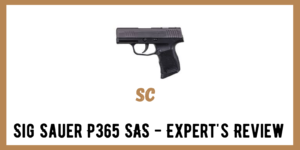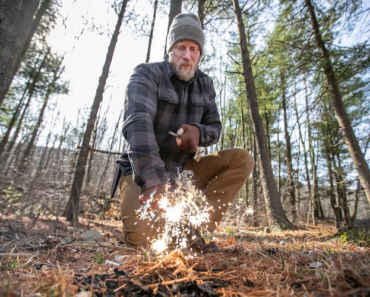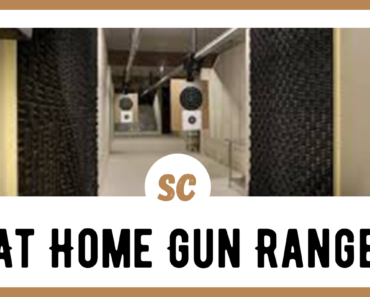Sig Sauer has made a name in the concealed carry pistol market in the last few years.
The introduction of the P365 line of semi-automatic pistols was a watershed moment for Sig in the civilian firearms market. Now Sig Sauer has taken the P365 line a step further with the Sig Sauer SAS.
For the record, SAS has nothing to do with the vaunted British SAS military units. SAS in Sigs parlance stands for SIG Anti-Snag. This descriptive acronym refers to the frame and slide enhancements that Sig has made to the P365 to enhance the concealability of these pistols.
The P365 has all of the refinements and features of the original P365, which has made it a favorite micro-compact pistol.
The SAS model is a pistol designed from the ground up as a pistol that is easy to concealed carry. Among polymer striker-fired guns, the SAS version is among the smallest that you can find. As a daily carry, this little pistol is one gun that you may find fits well into your plans.
A Little Bit of History
The Sig Sauer P365 gun was introduced in 2018. After a few teething pains with reliability issues, it has risen to become one of Sig’s most popular firearms. This was Sig’s first venture into the compact pistol market.
Overtime, the P365 has undergone several upgrades and enhancements. A number of variants of the P365 a now available. These variants and options make the Sig P365, a versatile firearm that fits many people’s uses.
The P365 SAS was introduced in 2019. You can even get several variants that offer options not available from other manufacturers of other subcompact and micro-compact pistols.
The P365 SAS as a pocket pistol is a very attractive and convenient carry pistol.
The Technical Specifications
Before we go any further without a look at the P365 SAS, let’s take a look at the technical specifications as they are provided by Sig Sauer.
It is always good to understand the basic information about any pistol before starting a critical examination.
- Caliber – 9mm Luger
- Mags Included – (2) 10 round magazines
- Sights – FT Bullseye sight
- Overall Length – 5.8 inches
- Overall Width – 1.0 inches
- Height – 4.1 inches
- Barrel Length – 3.1 inches
- Weight (unloaded) – 17.8 ounces
- Action – Striker fired
- Trigger – Standard curved shoe
- Barrel Material – Carbon steel
- Frame finish and material – Stainless steel
- Slide finish – Nitron
- Slide Material – Stainless Steel
It is easy to understand that this is a very small pistol that is easy to conceal under normal clothing. This firearm is so small that it makes pocket carry quite comfortable and easy.
Factory Features
An important question to ask when you make any gun purchase is what you get with the kit. In this case, Sig Sauer provides new users a complete firearms package that will have them on the range the same day.
- Flush mount FT Bullseye Fiber-Tritium Night Sight
- Flat controls for a completely smooth feel on the firearms sides to reduce or eliminate snag points.
- SIG Anti-snag treatment
- Striker fired design
- Crisp, clean trigger pull
- (1) 10-round magazine and (1) 10-round extended magazine included
Fortunately, most of the aftermarket accessories intended for the P365 will work quite well with the P365 SAS.
The only thing that we could find that isn’t a direct replacement is aftermarket sights. On the other hand, once you use the sights on the P365 SAS, you may not want to change the sights.
Digging into the P365 SAS
Anyone familiar with the Sig Sauer P365 will feel right at home with the P365 SAS. As the gun goes, these are fundamentally the same. Some of the differences are cosmetic while there are a few differences that can determine which pistol you choose for concealed carry.
Starting with the Slide
The slide is a logical place to start when examining the P365 SAS. The slide is one of the primary places where Sig modified the design of the P365 to create the SAS model.
At first look, it is easy to see the changes to the slide that prompted the SIG Anti Snag appellation on the model number.
Some shooters use the term “melted” to describe the slide on the P365 SAS. This refers to the much softer lines and edges on the slide. The corners are rounded and all the edges have been softened to reduce any chance of the slide snagging on a holster or clothing.
The stainless steel slide is finished with a matte treatment. This helps keep the slide from getting slippery as do the front and back serrations. One change you should notice is the lack of a cut-out for a front sight.
Speaking of the Sights
I wonder if Sig Sauer designed the P365 SAS with the sights already chosen. The tritium-fiber night sights were first developed and introduced by Meprolight.
This unique combination of fiber-optic and tritium sights that produce an illuminated sight that is visible during daylight is revolutionary.
These are fixed ring and dot sights, sometimes called bullseye sights. The forward dot is lined up inside the ring of the rear sight and when the dark circle around the dot is equal in all directions, the gun is on target.
Many shooters find this style of sight makes quick and easy target acquisition.
There are some reports of the tritium vial that powers the fiber-optic front sight may leak and go dark. We suggest that you check your prospective new gun at the gun store by covering the sights with your hands to see if the glow is easily seen.
If you can’t see the sight when shaded by your hand, look for another Sig P365 option.
Under the Slide
Removing the slide reveals the barrel, the recoil spring and the guide rod. The spring and guide rod are a single assembly and should not be disassembled by a regular user.
There are several aftermarket replacement guide rod assemblies that purportedly give better and faster operation.
I am not sure what a fraction of a second of difference in speed will make for the average shooter but, to each his own.
The carbon steel barrel length of 3.1 inches is not going to make this a world-class competition pistol. It is more than adequate if you keep your shoots to realistic distances is critical.
The Barrel
Sig originally included a ported barrel with the Sig Sauer P365 SAS. The concept was to reduce muzzle flip and control felt recoil.
It wasn’t long until Sig did away with this option altogether. There were several reasons for the change. Many users suffered an injury to the thumb on their offhand from the expelled gases.
Maintenance was also an issue that led to some reliability concerns. Sig felt it better to go with a non-ported barrel to get optimum ballistic performance and to enhance reliability.
Frame, Grip, and Controls
Shoot the Sig Sauer P365 and then pick up a Sig Sauer P365 SAS and you will find everything in the same place.
However, what you find may not be what you are expecting. To facilitate the non-snag features of the SAS model, Sig Sauer had to make some critical changes to the functional controls of the P365 and polymer frame.
Slide Takedown Lever
There are no takedown levers. Sig wanted to eliminate as many parts as possible that protruded from the sides of this pistol. This requires a different take on the takedown lever.
To remove the slide on the Sig Sauer P365 SAS, you much first pull all the way back and engage the stop. You use a tool such as a screwdriver to turn the release lever and then carefully release the stop and remove the slide.
Slide Stop Release
For all practical purposes, there is no slide stop on the Sig Sauer P365 SAS. Sig decided to reduce the size and put the stop lever and the takedown lever in small indentations on the frame.
You need a tool to perform a takedown which requires locking the slide back. You almost need a tool to engage the stop.
I found it almost impossible to disengage the stop with my shooting hand thumb as I do a larger handgun.
I normally carry a Glock 43 and have no trouble releasing the stop with my thumb. Not so on the Sig Sauer P365 SAS. Try as I might, I could not get the stop to release forward when locked back without changing my grip significantly.
Magazine Release
Like the other controls, Sig has reduced the size of the mag release and shortened it to keep the profile as close as possible. While the concept of anti-snag is commendable, there is a point where it goes too far.
The magazine release is a critical part of any reload of a semi-automatic pistol. If you can’t drop the mag cleanly and easily, you can’t reload quickly and efficiently.
I found it hard to manipulate the smaller magazine release button. However, when I did manage to find it and press it, the magazines fell away smoothly.
Most average people who carry concealed never anticipate, practice, or engage in magazine changes during reloads. As a purely defensive handgun, this is understandable. I just wish Sig had made it a little easier to change a mag quickly under a stressful situation.
Controlling and Gripping the P365 SAS
Often a micro-compact gun suffers from a lack of grip area that makes the gun easier to control. The grips are shorter, the overall gun is narrower, and, all too often, the stippling is inadequate for the job it should do.
Sig seems to understand these problems.
The stippling on the grip module of the P365 is almost perfect. It is aggressive enough to provide a solid non-slip grip, but not so rough that it begins to eat on your hands after a few rounds.
A larger high-capacity magazine may make handling the Sig P365 easier by providing more surface for your hand at the bottom of the mag well. Finding a place to rest your little finger on this gun can be a problem with the 10-round magazines.
Frame Size and Carry Issues
Almost everyone thinks that smaller is better when it comes to concealed carry firearms. I tend to disagree with this conclusion for several reasons.
The problem I find with a smaller micro-compact gun is the center of balance. The short barrel tends to push the center of balance back to the rear of the pistol.
If you routinely wear an inside-the-waistband holster, this puts the majority of the weight above the top of the holster and can cause sagging issues. I have found that an abdomen carry helps with this problem to some extent. As good as the Sig Sauer P365 SAS is, it suffers from this problem with most IWB holsters.
Other than this minor problem, the Sig P365 has a great grip angle and the grip module feels good in my hand. A micro-compact gun often leaves me with a feeling of dread if I know I am scheduled for range time with the pistol. I found this firearm to be comfortable enough to take to the range for regular practice.
Accessing a Micro-Compact Pistol from Concealed Carry
The first thing many new license holders notice when starting to carry concealed is the problems that can arise from simply drawing your pistol.
It can be hard to establish a firm grip on the pistol when it is snuggly held against your body by a good holster.
The art of the conceal makes it all too necessary to give up some level of access to your firearm. A handgun that is concealed is, by nature, hidden and out of sight.
This Sig is no different, and it may take you several tries to find a holster and carry position that provides a good combination of accessibility, security, and concealability.
Your choice of magazines can also impact the concealability of the gun. Longer high-capacity magazines may make the gun less comfortable and harder to conceal.
Hand Size and the Grip
Anyone with large hands may find it difficult to hold and control this gun. The short grip length and the small size can work against anyone with large hands that tend to overwrap the grip and put the little finger with no support.
Larger hands may also make it more difficult to access and draw the firearm from a concealed carry position.
Shooters must learn to jam a large portion of the thumb side of their hand between the firearm and their body to get a decent grip on the gun before the draw.
One problem people with small hands have shooting a much larger gun is getting their hands in the proper position. One advantage of a small frame gun is it allows smaller hands to find the proper grip.
The Trigger
Many shooters believe that the trigger groups are where the P365 excels over other small handguns in this class.
The Sig Sauer P365 SAS shares the same trigger groups as the P365. You can expect the same feel and performance on the P365 SAS trigger. I found the shoe on this firearm to be quite comfortable on my finger.
The pull weight is a bit heavy but that is to be expected on a pocket pistol with no external manual safety.
There is no trigger safety lever either as you would find on a Glock 43 or similar handgun. I am not sure if I am comfortable with depending on weight as a safety.
The trigger pull and travel are about standard for a striker-fired pistol. The initial take-up is rather light, but at a point, the full pull weight is felt on the trigger. I found that at this point, there was a slight amount of creep before a rolling break occurred. The trigger breaks cleanly and crisply when it does occur.
The trigger reset happened at about the point in the trigger return that the initial increase in the trigger weight was felt.
Since most concealed carry license holders don’t work the trigger reset like seasoned shooters, this may not be much of an issue. All in all, this is a decent and serviceable trigger for defensive firearms carried concealed.
Getting the Most from A Magazine
Sig ships each Sig SAS model with two 10-round capacity magazines.
One of these magazines is fitted with an extended magazine base plate to provide additional support when shooting. Many shooters opt to purchase additional magazines and often look for an extended 12-round capacity magazine.
Magazine capacity is often a factor for concealed carry guns.
A longer 12-round capacity magazine offers additional support when shooting. If you don’t want to carry a spare magazine, a 12-round capacity magazine is a good choice. Sig also opted for a steel magazine for reliability.
Each magazine has a polymer base that allows relatively easy magazine takedown for cleaning and are reliable during shooting.
At the Range
Of course, the best part of any gun review is the range time. Who doesn’t love to go shoot new and different guns just for fun? Oh well, back to work and this Sig P365 review.
The Feel of the Sig P365 SAS
Just handling the Sig P365 is nice. Despite its small size, the gun fits nicely in the hand and feels substantial enough to give confidence. I had two magazines for this gun, one standard and one with the extension.
I did notice that using the magazine without the extension left my little finger with no support. Only the finger next to my middle finger fit on the grip.
I switched to the longer magazine, loaded it with ball ammunition, and fired a quick 10 rounds just to get a feel for the gun.
The 10-round capacity magazine performed flawlessly as did the gun. I loaded both magazines and began firing my test ammunition in earnest. Even the one high capacity magazine we borrowed fed without any problems
What We Shot
For this range test, I brought 250 rounds of standard 115-grain ball ammunition and 50 rounds of assorted self-defense ammunition. Since this Sig P365 is chambered for 9mm caliber ammunition, I had plenty lying around my loading bench.
I like shooting a variety of different ammunition through a test gun to ensure that the guns I shoot will function and feed these types of ammunition. Some semi-automatic firearms, particularly these small-size guns may have trouble feeding some high-expansion ammo.
The Range Test
In all, I shoot 300 rounds of various loads through the Sig P365. The ranges varied from 7-yards to 50 yards.
Most of the self-defense rounds were shot at 7 or 15 yards since this is the distance where accuracy with this gun should be best. I typically use standard silhouette targets for my range tests
These micro-compact pistols are not a gun meant for long-range shooting. These guns are designed to be easily concealed and quick to draw and fire. Most incidents involving a self-defense shoot occur within this 7 to 15-yard distance. This range is where you want your best accuracy with these types of guns.
Function and Performance
Shooting the Sig P365 is much more comfortable than I was expecting. There is enough weight to manage the recoil while shooting and the grip module surface is enough to maintain a solid grip on the gun. In the hand, this feels like a larger gun than it actually is.
When shooting, I did notice that the muzzle rise was a little less than on my Glock 43. I attribute this to the slightly lower axis on the Sig P365 which changes the dynamics of the felt recoil. This should help your accuracy on follow-up shots with these guns.

The grip angle and rake seemed perfect for my hand and wrist. When firing the Sig P365 I didn’t experience the forearm and wrist fatigue that I normally experience when I shoot for long periods. The Sig P365 seemed to fit my hand well making these guns I would enjoy shooting on a regular basis.
I experience no failure to feed or misfire with this gun. I have experienced guns that don’t like to load high-performance self-defense loads. The steep feed ramp seems to be a problem but I didn’t experience this with the Sig P365 trying to load any of the ammo I shot. Even the 12-round magazine cycled the 12-round magazine without problems. I was impressed with the reliable performance of this
Accuracy
As I expected, the Sig P365 performed exceptionally in the accuracy tests. Most of the accuracy tests were shot at 7 and 15-yards. When firing during the tests, I prefer to shoot most of my rounds in a controlled manner to get the best performance from the gun. I do shoot several tests as quickly as possible to test function and my ability to stay on target with the gun.
At these short ranges, keeping the gun under control and on target proved easy even when firing rapid follow-up shots. I was able to shoot reasonably good groupings using both hands, firing off-hand and even using my weak hand. In my opinion, the Sig P365 shoots much better at these short ranges than my abilities. I had a much easier time keeping my shots on the targets than at the longer distances
At long ranges, the short barrel length on the Sig is the difference. At 25 yards I was able to get the gun to keep most of the rounds I fired on the target. At 50 yards, the one magazine I fired was about 50 percent on the black of the targets on a standard silhouette target. Since this is about the same results I expect with my Glock 43, I found the results acceptable. This is a subcompact pistol that performs well at what it is intended to do and probably shoots betters than my ability.
There are more accurate small guns on the market but none in this price range. For a self-defense gun, you won’t find the Sig SAS lacking in accuracy.
Accurate Sights
I found the sights easy to use, particularly at the close ranges where I shot most of my test ammo. The rear ring sight did take some time to learn to use. I often had trouble finding the dot in the rear ring. What I noticed was that if I wasn’t finding the dot in the ring quickly I usually had a faulty grip on the gun.
This surprised me as I don’t usually get this kind of feedback from a sight picture on full-size guns. This does tend to make you more accurate when you fire the gun. Compared to the three-dot sight on my Glock 43, I found the ring and dot to be easy to use and quite accurate.
The Trigger In Use
The Sig SAS uses the same trigger group as the P365. I felt the trigger pull was a little excessive. However, the lack of trigger safety or manual safety makes the heavier weight understandable, especially on a pocket pistol.
The break was consistent. I could judge from the amount of creep in the trigger about where the break would occur. This, in some ways, contributed to accurate shots and a consistent rate of fire on the range. I didn’t experience any slipping or problems finding the sweet spot with my trigger finger and I could feel the break and reset easily.
Carrying the Sig P365
I tried a number of different holsters with the Sig P365. This was a challenge since I didn’t want to invest in many holsters for a gun I don’t own so a trip to my local friendly gun store was in order. They were more than happy to oblige my strange requests.
I tried different holsters in different configurations and at different locations. In my opinion, the most comfortable holster for a Sig P365 with an extended magazine was an appendix carry IWB. Even with a high-capacity mag, the holster and gun fit nicely at this place and carried well.
For those who can’t manage to carry a full-size pistol on a regular basis, the Sig SAS is a great option as a carry choice. The only downside I see is anyone with large hands may have trouble finding a comfortable grip on this gun.
In Closing
I really like the Sig SAS and enjoyed my time at the range with this gun. I experienced zero issues during my tests. The gun performed well with all kinds of ammo that I tried. However, I would not suggest this as a first firearm for anyone who is just beginning to shoot.






















































